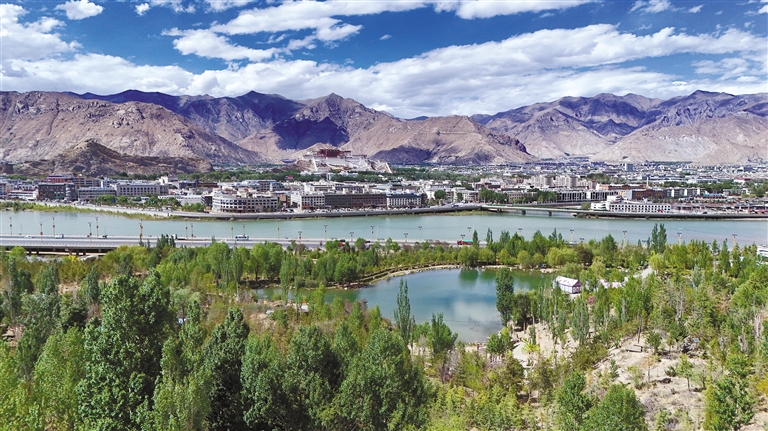Greening efforts enrich life, ecology in Xizang


For people in the Xizang autonomous region, the most common recreational activity between June and September is to "experience lingka".
In Tibetan, lingka has traditionally meant garden, but the term now broadly refers as well to activities in a garden, park or other outdoor setting. So "experiencing lingka" is akin to having a picnic or outing, where people spend a day in nature, surrounded by mountains and rivers, enjoying food, drinks and games with friends and family.
Dradul, a resident of Lhasa, the capital of Xizang, had such an experience earlier this month with his wife and some friends along the southern bank of the Lhasa River.
"There are designated areas for enjoying lingka, where you don't have to bring anything and simply order food you need there. We just brought some fruit, and then we sang songs and played dice together," Dradul said.
However, the 58-year-old recalled that things were quite different when he was a child.
Back then, Lhasa had few green spaces. Dradul and his family would sometimes bring homemade dishes and head to Norbulingka Park, one of the few green places in Lhasa at that time where residents were able to sit on the lawn and enjoy lingka. Other times, they would just find a spot in a marsh or sandy area and consider that a day out.
"Now the greenery in Lhasa is much better, and the roads are well-developed," he said.
This year marks the 60th anniversary of the founding of the Xizang autonomous region. Over the past few decades, Xizang has made numerous efforts in ecological conservation and restoration, adding greenery and beauty to the snowy plateau. Lhasa is a vivid reflection of such efforts.
In 2021, Lhasa launched a new greening project in the mountains to the north and south of the city. It is Xizang's first large-scale ecological restoration effort and a key livelihood project aimed at improving the well-being of local residents.
The project spans 35 towns in nine counties and districts in Lhasa, including Liuwu New District, where Dradul enjoyed his recent lingka. The goal of the project is to green an area totaling 137,300 hectares over 10 years, transforming Lhasa into a more ecologically friendly and livable capital city on the Qinghai-Tibet Plateau, one of China's most crucial ecological security barriers.
Dawa Yangdron, now in her 40s, has been working in Lhasa since 2002 on the cultivation of native tree saplings such as butterfly bush, silk-hair rose and Tibetan sea buckthorn. "They are all cold-resistant and drought-tolerant species that have high survival rates," she said.
In 2022, she joined the greening project, taking on a contract to plant trees across 213.3 hectares of mountains.
She said experts on her team who studied botany in Norway in the 1980s found that plants like rhododendron and golden cinquefoil, which are nearly extinct in Xizang, are commonly used for roadside landscaping in Norwegian cities.
"Those plants were cultivated from seeds collected in Xizang over 100 years ago," Dawa Yangdron said. Now her team is cultivating them with the hope that they will one day be widely planted as ornamental roadside shrubs in Xizang as well.
She said that whenever she feels mentally and physically exhausted, the sight of seedlings breaking through their seed shells gives her the strength to keep going.
"As a local resident, I know that both myself and my future generations will definitely live on this land. I feel obligated to make my contributions to greening the water tower of Asia," she said, referring to the Qinghai-Tibet Plateau.
However, planting trees at high altitudes is not an easy task.
The mountains to the north and south of Lhasa are between 3,600 to 4,050 meters above sea level, with slopes averaging 60 degrees. The soil is thin, rocky and difficult for planting, with up to 70 percent of the land covered in stones.
Tsedan Namgyal, a supervisor for an area of the project, said the mountains were almost barren in the early days of the project. Due to the hard soil, two or three workers could only dig three or four holes a day by hand, and the work had to be completed with drills, he said.
"Because the soil is hard, we had to fill the holes with water the day before, so that the soil would be moist by the time we brought in the saplings," he said.
Today, Tsedan Namgyal and his colleagues have planted more than 307 hectares of mountain slopes with species chosen according to soil depth, including elm, Chinese pine, walnut, mountain apricot, juniper, spruce, creeping juniper and sea buckthorn.
He said that one of the biggest challenges in high-altitude afforestation is transporting saplings.
Nowadays, this process has been revolutionized, thanks to drones that can carry up to 45 kilograms. Each round trip takes only three to four minutes, making the process five to eight times more efficient than the traditional method of transporting by mule or horse.
Kelsang Norbu, head of Lhasa's forestry and grassland bureau, said that with the help of drone delivery and smart irrigation technologies, the efficiency of the greening project has significantly increased.
"After more than three years of effort, over 71,330 hectares of mountains have been successfully afforested, with more than 120 million saplings planted. The survival rate has exceeded 85 percent," he said.
Once the project is completed, it is expected to increase annual water storage by approximately 49.8 million metric tons, with an average annual carbon sequestration capacity of 229,100 tons.
Kelsang Norbu added that as the greening of mountains is becoming increasingly visible, wild animals such as foxes and wolves are also becoming more common.
Gaer Jie, a research assistant at the China Tibetology Research Center, said that since the launch of the afforestation project in Lhasa, residents on the outskirts of the city have gained a new destination for "experiencing lingka", in addition to nearby woods, riversides or grassy areas.
"Thanks to the socioeconomic development in Xizang in recent years, what was once mainly a family activity has expanded — now workplaces, schools and communities also organize group lingka events. It has even become part of local tourism, drawing visitors to join in the experience and giving rise to a growing 'lingka economy'," she said.
"This is a vivid example of how the concept that 'lucid waters and lush mountains are invaluable assets' is being put into practice in Xizang," she added.
Contact the writers at mojingxi@chinadaily.com.cn

- Shanghai, Zhejiang brace for tsunami following Russian quake
- Typhoon Co-may makes landfall in Zhoushan
- Youth hailed as key force in promoting 'Shanghai Spirit'
- The Philippines 'purely maker of trouble and danger' in the South China Sea: Ministry
- China to earmark 90 billion yuan for childcare subsidies
- New Guangdong-Fujian expressway construction begins





































